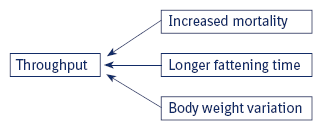2.6 How is “throughput (pig flow)” affected by Ileitis?
The aim of modern pig farming is the efficient use of the invested resources for profit maximization. For many years, this has been done by driving the production costs down. But low costs per pig alone will not guarantee a proper return on investment. The second factor which always plays an important role is the total throughput of pigs in the production system. The economically most sensible figure after cost is therefore the production of pork per pig space and year. Value is lost and invested money is wasted when a finishing floor is operating at less than full capacity. Throughput is most dramatically reduced by increased mortality, longer fattening times and higher body weight variability as an effect of Ileitis (Figure 2.5 a).

Figure 2.6 a
Factors influencing throughput in pig fattening
(production of pork per pig space).
It is obvious that for each pig which dies, throughput is reduced by the average weight of one market pig. The facility is used sub-optimally and all costs for feed, piglets, veterinary intervention etc. are lost.
Longer fattening times due to lower weight gains lead to a lower facility utilization by reducing the number of close outs per year (fattening cycle). Comparable effects are seen by disturbed pig flow due to increased body weight variation at the end of the fattening period. The most common strategy to deal with increased variability is sort pigs off in a sequential manner as they reach market weights. This will increase the opportunity costs from having empty pig spaces and reduce the production turns in finishing. Table 2.6 a shows the costs of increased fattening time on the production per pig place and year.
With increased fattening time, less pork can be sold per fattening place. The lost opportunity is about 2.6 ¤/fattening place and year (per additional day in fattening). The additional costs for feed are about ¤0.96 per fattening place. This shows that the longer fattening time has a substantial influence on the throughput and the resulting return on investment in fattening.
Healthy pigs without Ileitis are able to make full use of their genetic potential for growth and will show more uniform slaughter batches. The resulting production of more pork per animal space and year allows a better use of the invested capital and improved return on investment.

Table 2.6 a
The impact of increased
fattening time* on the economic loss per fattening place and year.
* In relation to the base level: 25 kg – 115 kg, 129 d fattening time, feed conversion rate 3.0, service time between the intervals 5 d, feed price ¤170/t; pork price ¤1.4/kg.
© Boehringer Ingelheim Animal Health GmbH, 2006
All rights reserved. No part of this Technical Manual 3.0 may be reproduced or transmitted in any form or by any means, electronic or photocopy, without permission in writing from Boehringer Ingelheim Animal Health GmbH.






